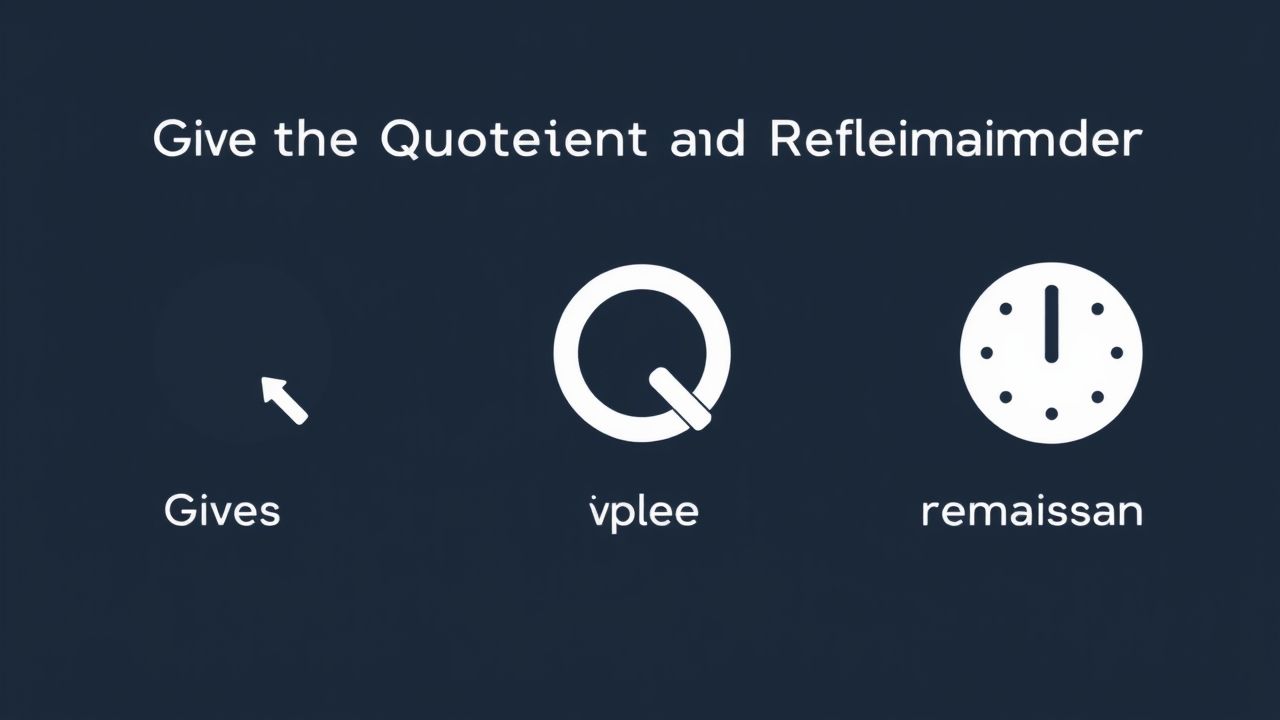In mathematics, division is a fundamental operation used in daily life, from sharing objects evenly to complex calculations in various fields. One of the most basic and essential concepts in division is understanding how to give the quotient and remainder when dividing two numbers. This concept not only helps in solving numerical problems but also in improving one’s logical and critical thinking skills. Whether you are a student learning the basics or someone brushing up your knowledge, understanding how to give the quotient and remainder accurately is crucial for building a strong foundation in arithmetic.
Understanding Division
Definition of Division
Division is the process of splitting a number, known as the dividend, into equal parts by another number, known as the divisor. The result of the division is called the quotient, and if there is anything left after the equal sharing, that part is referred to as the remainder.
Formula of Division
The basic formula for division involving a remainder is:
Dividend = (Divisor à Quotient) + Remainder
This equation is the key to understanding how division works and how to verify your answer after calculating the quotient and remainder.
What Is a Quotient?
The quotient is the number of times the divisor fits completely into the dividend. It tells us how many full groups can be formed using the divisor from the dividend.
Example of Finding the Quotient
If we divide 17 by 4:
17 ÷ 4 = 4(Quotient)
4 fits into 17 four times because 4 Ã 4 = 16, and 17 is just one more than 16.
What Is a Remainder?
The remainder is the leftover part after the division when the dividend does not divide evenly by the divisor. It is always less than the divisor.
Example of Finding the Remainder
Using the same example:
17 ÷ 4 = 4 R1
The remainder is 1, because 17 – (4 Ã 4) = 1.
Steps to Give the Quotient and Remainder
Step-by-Step Process
- Step 1: Identify the dividend and the divisor.
- Step 2: Determine how many times the divisor fits into the dividend completely. This gives the quotient.
- Step 3: Multiply the quotient by the divisor.
- Step 4: Subtract the result from the dividend to find the remainder.
Another Example
Let’s divide 22 by 5:
- Divisor = 5
- Dividend = 22
- 5 goes into 22 four times (5 Ã 4 = 20)
- 22 – 20 = 2 (Remainder)
Quotient = 4, Remainder = 2
Why Understanding Quotient and Remainder Matters
Practical Applications
Learning how to give the quotient and remainder helps in many real-world situations. For example:
- Sharing items equally among people and knowing how many will be left over
- Calculating time intervals and leftover minutes or seconds
- Programming logic that requires integer division and remainder operations
Mathematical Importance
The concepts of quotient and remainder are foundational in algebra, number theory, and modular arithmetic. Many competitive exams and logical reasoning tests include questions based on these ideas.
Working with Larger Numbers
When dealing with larger numbers, the same principles apply. You can use long division to find both the quotient and the remainder.
Example: 123 ÷ 11
Using long division:
- 11 goes into 123 eleven times (11 Ã 11 = 121)
- 123 – 121 = 2
Quotient = 11, Remainder = 2
Using Division in Word Problems
Word problems often require understanding how to give the quotient and remainder. For example:
Word Problem
A teacher has 29 pencils and wants to give 5 pencils to each student. How many students will get pencils, and how many pencils will be left?
- Dividing 29 by 5: 5 goes into 29 five times (5 Ã 5 = 25)
- 29 – 25 = 4
Quotient = 5 students, Remainder = 4 pencils
Understanding Division in Programming
In programming languages, division often returns both the quotient and the remainder using special functions. For instance, in Python, the//operator gives the quotient, and the%operator gives the remainder.
Example in Python
quotient = 17 // 4 remainder = 17 % 4
These will return 4 and 1 respectively, matching our earlier example.
Common Mistakes to Avoid
- Confusing the dividend with the divisor
- Forgetting to multiply the quotient by the divisor before subtracting to find the remainder
- Reporting a remainder that is greater than or equal to the divisor (this indicates the division was not complete)
Knowing how to give the quotient and remainder is a vital skill in basic mathematics. Whether you’re performing manual calculations, solving problems in a test, or programming solutions to mathematical tasks, this knowledge is highly valuable. By understanding the process of division and practicing with examples, you can accurately determine the quotient and remainder in any situation. This concept is more than just a step in arithmetic it is a tool for reasoning, estimating, and solving problems in everyday life.
